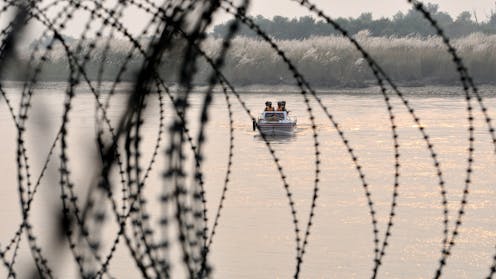China’s insertion into India-Pakistan waters dispute adds a further ripple in South Asia
- Written by Pintu Kumar Mahla, Research Associate at the Water Resources Research Institute, University of Arizona

With the future of a crucial water-sharing treaty[1] between India and Pakistan up in the air, one outside party is looking on with keen interest: China[2].
For 65 years, the Indus Waters Treaty[3] has seen the two South Asian rivals share access and use of the Indus Basin[4], a vast area covered by the Indus River and its tributaries that also stretches into Afghanistan and China.
For much of that history, there has been widespread praise for the agreement as a successful demonstration of cooperation[5] between adversarial states over a key shared resource. But experts have noted the treaty has long held the potential for conflict[6]. Drafters failed to factor in the effects of climate change, and the Himalayan glaciers that feed the rivers are now melting at record rates[7], ultimately putting at risk the long-term sustainability of water supply. Meanwhile, the ongoing conflict over Kashmir[8], where much of the basin is situated, puts cooperation at risk.
With treaty on ice, China steps in
That latest provocation threatening the treaty was a terrorist attack[9] in the Indian union territory of Jammu and Kashmir on April 22, 2025. In response to that attack, which India blamed on Pakistan[10] and precipitated a four-day confrontation, New Delhi temporarily suspended[11] the treaty.
But even before that attack, India and Pakistan had been locked in negotiation over the future of the treaty – the status of which has been in the hands of international arbitrators[12] since 2016. In the latest development, on June 27, 2025, the Permanent Court of Arbitration issued a supplementary award[13] in favor of Pakistan, arguing that India’s holding of the treaty in abeyance did not affect its jurisdiction over the case. Moreover, the treaty does not allow for either party to unilaterally suspend the treaty, the ruling suggested.
Amid the wrangling over the treaty’s future, Pakistan has turned to China for diplomatic and strategic support[14]. Such support was evident during the conflict that took place following April’s terrorist attack, during which Pakistan employed Chinese-made fighter jets[15] and other military equipment against its neighbor.
Meanwhile, in an apparent move to counter India’s suspension of the treaty, China and Pakistan have ramped up construction[16] of a major dam project that would provide water supply and electricity to parts of Pakistan.
So, why is China getting involved? In part, it reflects the strong relationship between Pakistan and China[17], developed over six decades.
But as an expert in hydro politics[18], I believe Beijing’s involvement raises concerns: China is not a neutral observer in the dispute. Rather, Beijing has long harbored a desire to increase its influence[19] in the region and to counter an India long seen as a rival. Given the at-times fraught relationship between China and India – the two countries went to war in 1962[20] and continue to engage in sporadic border skirmishes[21] – there are concerns in New Delhi that Beijing may respond by disrupting the flow of rivers[22] in its territory that feed into India.
In short, any intervention by Beijing over the Indus Waters Treaty risks stirring up regional tensions.
Wrangling over waters
The Indus Waters Treaty has already endured three armed conflicts between Pakistan and India, and until recently it served as an exemplar of how to forge a successful bilateral agreement between two rival neighbors.
Chinese investment in Pakistan’s hydropower sector presents substantial opportunities for both countries in regards to energy security and promoting economic growth.
The Indus cascade project[40] under the China-Pakistan Economic Corridor initiative, for example, promises to provide cumulative hydropower generation capacity of around 22,000 megawatts[41]. Yet the fact that project broke ground in Gilgit-Baltistan, a disputed area in Pakistan-controlled Kashmir, underscores the delicacy of the situation.
Beijing’s backing of Pakistan is largely motivated by a mix of economic and geopolitical interests[42], particularly in legitimizing the China-Pakistan Economic Corridor. But it comes at the cost of stirring up regional tensions.
As such, the alignment of Chinese and Pakistani interests in developing hydro projects can pose a further challenge to the stability of South Asia’s water-sharing agreements, especially in the Indus Basin. Recently, the chief minister of the Indian state of Arunachal Pradesh, which borders China, warned that Beijing’s hydro projects in the Western Tibet region amount to a ticking “water bomb[43].”
To diffuse such tensions – and to get the Indus Waters Treaty back on track – it behooves India, China and Pakistan to engage in diplomacy and dialogue. Such engagement is, I believe, essential in addressing the ongoing water-related challenges in South Asia.
References
- ^ crucial water-sharing treaty (theconversation.com)
- ^ China (asiatimes.com)
- ^ Indus Waters Treaty (theconversation.com)
- ^ the Indus Basin (www.grida.no)
- ^ successful demonstration of cooperation (www.worldbank.org)
- ^ long held the potential for conflict (theconversation.com)
- ^ now melting at record rates (snu.edu.in)
- ^ ongoing conflict over Kashmir (www.bbc.com)
- ^ terrorist attack (www.chathamhouse.org)
- ^ India blamed on Pakistan (www.politico.com)
- ^ temporarily suspended (www.mea.gov.in)
- ^ in the hands of international arbitrators (pca-cpa.org)
- ^ issued a supplementary award (docs.pca-cpa.org)
- ^ diplomatic and strategic support (www.specialeurasia.com)
- ^ Chinese-made fighter jets (www.scmp.com)
- ^ ramped up construction (economictimes.indiatimes.com)
- ^ strong relationship between Pakistan and China (www.cfr.org)
- ^ expert in hydro politics (scholar.google.com)
- ^ increase its influence (www.cfr.org)
- ^ went to war in 1962 (www.britannica.com)
- ^ sporadic border skirmishes (www.aljazeera.com)
- ^ disrupting the flow of rivers (orcasia.org)
- ^ Riccardo Pravettoni (www.grida.no)
- ^ CC BY-SA (creativecommons.org)
- ^ Under the initial terms (treaties.un.org)
- ^ initial demand was for 25% of the Indus waters (www.penguin.co.in)
- ^ unresolved land disputes (www.tandfonline.com)
- ^ 65% of Pakistanis live in the Indus Basin region, compared with 14% for India (openknowledge.fao.org)
- ^ India has threatened (www.reuters.com)
- ^ comes from hydropower, and nearly 21 hydroelectric power plants (www.csis.org)
- ^ Diamer Bhasha Dam (tribune.com.pk)
- ^ Kohala Hydropower Project (cpec.gov.pk)
- ^ as a stakeholder in the Indus Waters Treaty, too (yris.yira.org)
- ^ framed India (asiatimes.com)
- ^ water as a weapon (baijiahao.baidu.com)
- ^ lies in China’s Western Tibet region (kan.china.com)
- ^ reaffirmed China’s support for Pakistan (lkyspp.nus.edu.sg)
- ^ announced it was to accelerate (www.livemint.com)
- ^ Pakistan Water and Power Development Authority (www.wapda.gov.pk)
- ^ Indus cascade project (www.idsa.in)
- ^ around 22,000 megawatts (idsa.in)
- ^ geopolitical interests (www.sadf.online)
- ^ ticking “water bomb (www.livemint.com)
Authors: Pintu Kumar Mahla, Research Associate at the Water Resources Research Institute, University of Arizona




